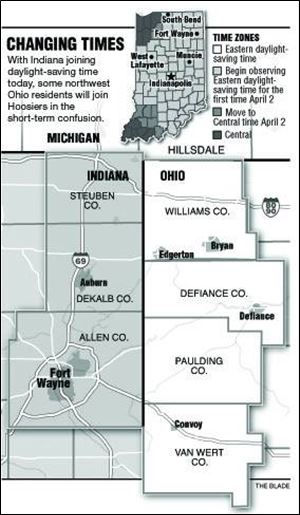
Times are a-changin' across all of Indiana
4/2/2006
CONVOY, Ohio - Lori Royse had a simple way of making sure she got from her northwest Ohio home to her job in Fort Wayne, Ind., on time.
"The thing in my head was always, leave at 8 to get there at 8," she recalled.
Not anymore.
For the first time in decades, the entire state of Indiana joined Ohio and Michigan and 45 other states and 70 nations at 2 a.m. today in turning its clocks forward one hour. Arizona and Hawaii don't observe daylight-saving time.
Mrs. Royse, who lives in Convoy, Ohio, in Van Wert County, said the challenge for her will be remembering there is no time change when she drives to work at the Allen County Prosecutor's Office in Fort Wayne tomorrow. Her husband, Dave, is a police officer for Allen County, Indiana.
"For almost as far back as I can remember, we've done it," she said. "For me, it's just part of spring and fall. For the first day, you have a couple mini heart attacks because you think you set the clock wrong."
Ken Moffett, who drives about 35 miles from his home north of Bryan to an auto supply plant in Auburn, Ind., said he always enjoyed the time change because he works second shift.
"I always liked it just because you had that extra hour to get things done before you had to go to work," he said.
His wife, Lindsey, said she took advantage of the fact that Indiana did not observe daylight-saving time.
"We would go to Fort Wayne, eat dinner, and beat the dinner crowd," she said. "We could stay and go shopping and be there when the stores were still open."
The issue, which has been debated in the Hoosier state for years, is no longer up for discussion.
Last year, Indiana Gov. Mitch Daniels convinced the Legislature to pass a law requiring all counties to follow daylight-saving time. He and proponents such as the Indiana Chamber of Commerce contended it would be good for business because it would eliminate mix-ups over everything from parts deliveries and conference calls to business meetings and airline schedules.
"We had a very confusing situation in Indiana where six months of the year we were on Chicago time and the other six months we were on the same time as New York," said Jane Jankowski, spokesman for Governor Daniels. "He believed this was a very simple thing we could do to improve our economy."
Confusion still may reign in the Hoosier State at least for a time.
Shortly after Indiana agreed to use daylight-saving time, Congress decided to expand daylight-saving time so that beginning in 2007, it will begin on the second Sunday in March and end on the first Sunday in November.
And there are still the differing time zones in Indiana. Eighteen counties in the northwestern and southwestern parts of the state are now in the Central time zone, putting them an hour behind Indiana's other 74 counties, which like Ohio and Michigan are on Eastern time.
That is just slightly less confusing than past years when 10 counties were on Central time, 77 were on Eastern standard, and five others in the Eastern time zone chose to be on daylight-saving time.
Just why Indiana ignored daylight-saving time for so long is not entirely clear. Some historical accounts suggest it was a debate between city dwellers who favored "fast time" as it was referred to in the 1940s and farmers who thought it was unnatural and not good for their livestock.
As the years went on, it became a local decision for many counties, and those closer to Chicago, for example, wanted to align themselves with Chicago time. The result was a patchwork of Central and Eastern time either on or off daylight-saving time that became known as "Indiana time."
For Gail McKinnon, a Perrysburg High School and University of Toledo graduate who teaches math at Van Wert High School, the change to daylight-saving time is a welcome one.
Living in New Haven, Ind., for the last 19 years, she said being an hour behind Ohio time was difficult when her three children were small.
"Our school starts at 8 o'clock, so when Indiana wasn't on daylight-saving time, it was like I was getting to school at 7 a.m.," she explained. "For many years, I had to have the kids dressed, fed, and dropped at the baby-sitter's at 6 a.m., and they didn't like that at all."
Fog delays didn't help any.
"Another teacher I used to work with used to ride with me," Mrs. McKinnon said. "One day, we had a two-hour delay, and she showed up at my house an hour before we really needed to leave. She had gotten it confused."
While she didn't mind the time change after her children grew up, Mrs. McKinnon said she's happy to be gaining the hour of daylight and thinks natives of her adopted state will feel the same.
"I'm delighted," she said. "I think it's a good idea, and I think people in Indiana will like it better than they think they will."
Those with ties to Ohio seem to agree.
Jeff Logsdon, a meteorologist with the northern Indiana office of the National Weather Service, grew up in Findlay and for years listened to his mother back in Findlay ask if he was an hour ahead or an hour behind.
"A lot of people in Indiana are still very much opposed to it. I'm in favor of it," Mr. Logsdon said. "I'm looking forward to an extra hour of daylight in the evening. I don't need to have the sun coming up at 4:30 a.m."
Contact Jennifer Feehan at: jfeehan@theblade.com or 419-353-5972.